Many enthusiasts often look back to the late 1960s and early 1970s as the golden days of the automobile. Gas prices were down, horsepower was up, and memorable nameplates like Chevelle, Cougar Eliminator, and Duster spewed leaded gasoline fumes as they raced from stoplight to stoplight. Could it be possible that we look back on the heyday of the muscle car with rose-colored glasses? According to the Environmental Protection Agency, we are; cars today are more efficient, powerful, and faster than they’ve ever been.
Since 1975, CO2 and fuel economy trends in the United States have gone through four distinct phases, with the two mirroring each other since they have an inverse relationship. The first phase was a rapid increase in fuel economy and decrease in CO2 emissions from the 1975 through 1981 model years. The next phase saw a slightly slower increase in fuel economy and decrease in CO2 emissions until 1987. The third phase was an actual decrease in fuel economy and increase in CO2 emissions up until 2004. The final phase is the one we’re in now, with an increase in fuel economy and decrease in tailpipe emissions from 2005 to present.
The EPA attributes the dip in fuel economy and bump in CO2 emissions to the increasing popularity of trucks and SUVs at the time. Even with truck and SUV sales still on the rise, 2010 saw an all-time high in fuel economy at 22.6 mpg, and low in CO2 emissions at 394 g/mi. Though final data for last year is not yet in, the EPA’s preliminary data shows that 2011 will top 2010, with the expected average fuel economy to be 22.8 mpg, and CO2 emissions to be 391 g/mi.
This increase in fuel economy and decrease in tailpipe emissions can not only be attributed to new automotive technologies (more on that in a bit), but also to automakers increasing their fleet-wide fuel economy averages. The EPA report notes that ten of the 13 highest-selling automakers in the U.S. (representing 99 percent of the market) increased their fuel economy averages in the last three years. Hyundai, Kia, and Toyota topped the list. Hyundai’s 2011 average is projected to be 27.5 mpg, up from 25.1 mpg in 2009. Kia’s 2011 projected average was 27.2 mpg, up from 2009’s 24.2 mpg, making it the most improved automaker. Among the top three, Toyota was the only one that dropped; in 2009 its corporate average fuel economy was 25.4 mpg. In 2011, it fell to 25.1 mpg.
Though they all saw improvements relative to 2009, Chrysler, Mercedes-Benz, and Ford rounded out the bottom three of the list. Ford’s 2011 average fuel economy was 21.3 mpg, Mercedes-Benz’s was 20.0 mpg, and Chrysler’s was 19.7 mpg.
Now for the good stuff. Even with fuel economy up, the EPA reports horsepower, 0-60 mph times, and somewhat strangely — weight, are all the highest (save for 0-60 times which are the lowest) they’ve ever been. In 2010 the average vehicle produced 214 horsepower — a number the EPA expects to shoot up to 228 once the final 2011 figures come in. The ever-important 0-60 mph times have also fallen to 9.6 seconds in 2010, and are expected to fall further to 9.3 seconds for 2011. Normally the enemy of both performance and fuel economy, weight as also crept up the past couple years from 3917 lbs. in 2009 to 4002 lbs. in 2010. The EPA expects weight to further rise to 4084 lbs. in 2011.
All that extra weight can be attributed to more trucks and SUVs being on the roads, but the credit for the increased performance goes entirely to the new technology making its way into modern day automobiles.
Fuel-saving technologies like variable valve timing, gasoline direct injection, and hybrid technology have all been on the increase since they started becoming widely implemented in the middle of the last decade. Variable valve timing has seen its market share increase from 39 percent in 2004 to 94 percent last year. Gasoline direct injection has seen gains too; in 2008 only 2.8 percent of all vehicles sold in the U.S. featured the technology. The EPA expects that number to jump to 13.7 percent when the final 2011 numbers are tallied. The bane of many enthusiasts, hybrid powertrains have increased from 0.5 percent in 2004 to 4.0 percent in 2011.
That doesn’t necessarily mean that the modern automotive golden age is coming to an end anytime soon. Some technologies that regularly put smiles on the faces of enthusiasts have increased the last couple years. Forced-induction availability continues to grow as turbo and supercharged engines grab increased market share, reaching 7.4 percent last year. V-8s also are grabbing more market share; although nowhere near the peak it experienced in 1975 when 62 percent of all vehicles sold in the U.S. packed eight-cylinders under the hood, V-8s now account for 16 percent of the U.S. — the highest it’s been since 2009. The last factoid that’ll make you happy? That manual transmission usage is on the increase — 5.1 percent of all vehicles sold in the U.S. had a third pedal, up from 2010’s low of 3.8 percent.
You can check out all of the charts and graphs for yourself in the gallery below.
Source: Environmental Protection Agency
- Since 1975 fuel economy has generally trended upwards while CO2 emissions have generally gone down.
- Corporate fuel economy averages from 2009 through 2011 for the 13 best-selling automakers in the U.s.
- Though weight has increased since 1975, cars now produce more horsepower and are faster then ever before.
- A breakdown on the market share of automotive technologies for 1975, 1987, 2004, and 2008 through 2011.


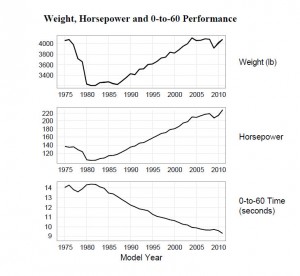
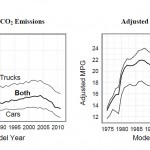
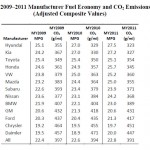


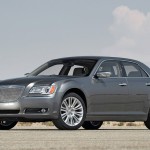

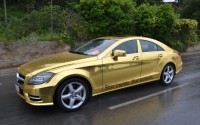
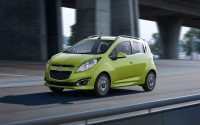
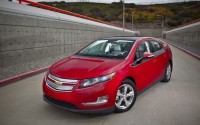














The extra weight attributed to more trucks and SUVs on the road? Perhaps some of it sure. But all that extra electronics and safety features add weight too. I remember an exhibit at the Chrysler museum that showed the difference in wiring of the cars from the 60s-70s and today. I forget the exact numbers but it was something like back than there was about 14 pounds of wiring while today there is a couple of hundred pounds. Pros and cons to everything.
Well that’s good news. Long live the Manual. Would nice to see more cars then trucks or SUVs selling maybe we get some push for nicer looking cars and more coups.
I think it is now like the late sixties- early seventies, with lots of fast cars, but it will soon be like the mid seveties, where you won’t be able to buy a fast car, because they will need to get 40-50mpg.
What we need is cheaper electric and uni-personal cars. More efficient, powerful, safer is important, but nobody is thinking about the space on the streets. There are many people driving everyday 5-passengers cars by themselves occupying unnecessary space that could be used for more cars or reduce the traffic jam.
Maybe so, but more electric means more fossil fuels—coal, natural gas, but at least we don’t have to import coal and gas like we do oil. Even though cars are smaller now, there is usually only one person driving during the morning commute, so maybe a uni-personal car would be the most efficient.
but then you have to think what if you need to pick someone up or drop someone off somewhere or something like that. I honestly dont like small cars like smart cars (if thats what you’re talking about).
Cars also have less soul than ever before, thanks to the electronics that driving easier and less involved every year.
If you and I vote with our wallets we can help to prolong the manual transmission.
Cars may be more powerful and efficient than ever, but they’re also more expensive than ever. That’s the real cost of regulation.
Yet diesels seem to have gotten worse because of all the crappy regulations
From a fuel efficiency standpoint, yes they have gotten worse, however from an emissions standpoint, 3/4 and 1 ton diesels are actually cleaner than gas vehicles, in city’s like LA, the emissions coming from the tail pipe of a diesel truck is actually cleaner than the air in the atmosphere.
In regards to that, I forget what show I saw it on, but they took a diesel pickup, measured the particles in the air going into the truck and out of the truck and the truck was actually cleaning the air!
well i think anyone who new anything about cars new that as usual, Chrysler was last.
It may not help your opinion on the matter but Chrysler as a whole actually produced less tailpipe emissions than Mercedes-Benz.
Well, they are right in that cars are more efficient, more horsepower, and safer, too. They are however, smaller on the outside and inside. The so-called full-sized cars don’t hold six adults like they used to. Shorter wheelbases mean less rear passenger footroom. I think that plus the radial and performance tires now make less smoothness overall, too. I don’t miss the large cars. I was a teenager in the 60s and had accidents with my dad’s large cars that had 140″ wheelbases. I couldn’t park the big Chevy Impala my driver training class had. My mom’s Buick couldn’t fit in the garage she had. The smaller Chrysler 300 or LaCrosses would easily do that…so maybe this is the golden age of cars, even if they’re not large or as stylish with their smooth V8s.
Cars today hold just as much interior space, people are just bigger. Cars nowadays don’t have the front bench seats but hatchbacks can carry more than ever, without being station wagons or yachts. Performance and handling are way up. Both suspension and tire technology are much improved.
CO2 emissions and gas mileage are up as well. Ergonomics are also much better. Today’s automobile is far superior in every way to the cars of the 60′s (Styling is in the eye of the beholder). Look at today’s performance cars, they are just as gorgeous as the cars of the 60′s and earlier. V8′s are not as smooth as you think you remember. Engine balance and vibration reduction today is far superior and many v6 and 4 cylinder engines are just as smooth. V8′s still exist today and those are far superior to those of the 60′s. Torque curve’s are flatter and smoother than they were and torque is almost instantaneous on most performance cars with turbos. The day of the V8 is done. I still love the sound of the V8 in my Ram, but it’s performance and combined efficiency is nowhere near my Cobalt SS turbo.
The technological advancement of cars in the last 10 years is outstanding. The 2002 Dodge Ram with a 10-13mpg, 245hp, and 335lb/ft tq compared to the 2012 Ram at 13-19mpg, 390hp, and 404lb/ft tq is a significant improvement. This is truly the golden age of cars especially when compared to the early 2000′s, 90′s 80′s and end of the 70′s.
the cars are the same size now as they were before,
people are just much fatter these days… look around…. have you seen all the fat bastards milling around